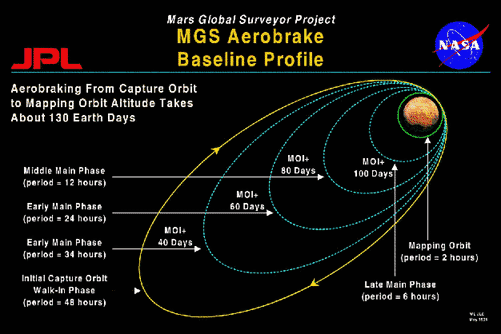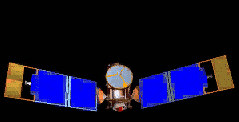
Mars Global Surveyor Magnetic Field Experiment
MGS Aerobraking

Click on picture for larger view
Aerobraking is a technique used by NASA to reduce the amount of fuel required to slow down the Mars Global Surveyor spacecraft as it approached Mars. Just like an airplane uses spoilers and flaps to slow down prior to landing, the MGS spacecraft used the drag of the Martian atmosphere on its solar panels to slow down as an alternative to using thrusters which requires extra fuel and, therefore, extra weight and cost. Aerobraking was to take 6 months and several orbits around Mars to reduce the apoapsis (highest point in orbit) and align the MGS spacecraft in the proper polar orbit. The duration of the aerobraking phase is directly related to how fast Mars' relatively thin atmosphere reduces the spacecraft's velocity. At the start of aerobraking, the solar panels were configured in a manner to increase drag and slow the spacecraft down. Also, extra flaps at the end of the solar panel were unfolded to further increase the drag.
A problem with one of the solar arrays reduced the amount of drag that the spacecraft could safely use. Aerobraking was done off and on during 17 months to allow a decreased amount of drag to do the job over a longer period of time.
More on how aerobraking works.
 |
 |

Quicktime Movie of Aerobraking Configuration Change (600K)
Aerobraking was first attempted successfully at Venus during the Magellan mission. Mars was the first complete test for this new method of slowing down spacecraft. Aerobraking allows NASA to deliver missions at a lower cost because the lower mass of the spacecraft requires a smaller and less expensive launch vehicle to accomplish the same objectives.
The MAG/ER contributed to the execution of this phase of the mission by making measurements of the local electron density by operating the ER in a special way called "Langmuir Probe" mode. This information together with models of the Martian ionosphere was used to estimate the neutral density of the atmosphere and its drag on the spacecraft. The atmospheric density at Mars was not well known and can vary dramatically as duststorm periods arise. The atmospheric friction against the mag sensors mounted on the edge of the solar panels elevated their temperature to almost 65 degrees C (149 degrees F) during each aerobraking pass. This did not cause any problems to the instrument.
Contributors: Monte Kaelberer, Sandy Kopman, David Brain, Cisco Perin, and Theresa Valentine






